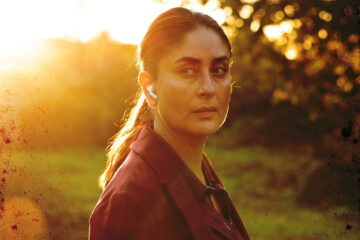Before Virasat, people were beginning to write off Anil Kapoor, who hadn’t given a hit in three years.
The year was 1997, and Anil Kapoor had a problem. It had been three years since he’d given a hit in the form of Laadla. In movie terms, three years is considered a lifetime. While a whole new generation of superstars had arrived on the scene, with the most recent being a certain Shah Rukh Khan, whose chilling negative portrayal in Darr had critics buzzing, Anil Kapoor’s cache with the public was dwindling just like the length of his once-famous luxuriant mustache.
The Writing was on the Wall
After the success of Laadla, Anil Kapoor gave flop after flop in movies such as Andaz (1994), 1942: A Love Story (1994), Mr. Azaad (1994), Trimurti (1995), Rajkumar (1996), Loafer (1996), and Mr. Bechara (1996). Even while his work was being appreciated, the numbers weren’t good. The writing was on the wall – the era of ‘The Khans’ had started, and the ‘Jhakaas generation’ was winding down. Anil Kapoor was being pushed on a downward spiral into obscurity. He wouldn’t be the first or the last one to have experienced this rollercoaster ride. By all metrics, it had been a fairly impressive career that had seen the highs most fellow actors craved. But it had been a while since any of his latest movies had resulted in catchphrases on the level of virality enjoyed by ‘My name is Lakhan’ or ‘One two ka four.’
The Source of Anil’s Appeal
The problem wasn’t that the hunger had died. Nobody could deny Anil Kapoor’s commitment to his craft. It was something much more challenging to pin down. Could it be his moonch? Since the stylish Raj Kumar era, nobody had been more revered for their facial hair than Anil Kapoor. Jackie Shroff, aka Jaggu Dada, is the exception, but he never had the sustained level of fame that Anil Kapoor had enjoyed throughout the 80’s and until the mid-90’s. Just like Samson had his hair, could Anil Kapoor’s powers of success be linked to the length of his facial hair? While there was no statistical or empirical data to back this theory, what happened next in 1994 is now part of Bollywood folklore.
Anil Kapoor needed a hit, something to put him back in the hearts of the masses. To do that, he did what filmmakers and actors have been doing until today; he went for the tried and tested route. He decided that he’d remake a regional hit movie. But he couldn’t find one that worked. Some say that when it’s meant to be, nothing can come your way, and that’s how, in 1994, the movie literally fell into the lap of a despondent and depressed Anil Kapoor. Thevar Magan was a Tamil film starring and written by the great Kamal Hasan. On a side note, it’s telling that in finding his way back to the top, Anil went for the movie where the leads had the most extravagant moustaches.
Anyway, back to the story.

Kamal wanted a Hindi remake of his movie with the great Dilip Kumar in it, but the latter retired from acting. Finally, Kamal Hasan gave Anil Kapoor his blessings for the Hindi remake.
It would be a tall task to remake a movie that had enjoyed a 175-day run at the box office, won 5 National Awards, and been India’s entry to the 65th Academy Awards. But while everyone else might have lost faith in him, one thing that Anil Kapoor had never lost was the guts to put it all on the line. After roping in Priyadarshan to direct and the ever-reliable Amrish Puri to play the role of Rana Thakur, Anil knew he needed one last thing. The X factor that would push him back from the brink and into the limelight.
Shahrukh had his K-k-k-iran, Aamir had the chocolate boy charm, and Salman had Didi’s going dewana for their devars. Even Sanju was Tamma Tamma-ing his way into people’s hearts. Anil Kapoor needed his X-factor. After three years of decent-length moustache and dismal box-office returns, Anil Kapoor had an epiphany. Somebody once said that if you have a racing Thoroughbred, you don’t keep it in the stable; you let it run.

Anil Kapoor let his moonch do the heavy lifting. And the rest, as they say, is history. In retelling the story of a foreign-returned boy, out of touch with his rural values, audiences saw the Anil of old. People will say it was Tabu’s screen presence and effortless yet endearing simple village girl charm. It was Amrish Puri’s portrayal of a gruff and stern father who secretly longs for his favorite son to take up the mantle. Pooja Batra’s modern city girl appeal. The unforgettable music that played behind Ravi K. Chandran’s mesmerizing camera work. All of it is true.
But long after the credits had finished and as audiences kept coming back to watch it over and over again, it was to watch Anil Kapoor with the shoulder-length hair and the flowing mustache, who finds his inner Micheal Corleone and grows up right before our eyes. He does what his father had always hoped he would do. In the movie’s climax, as the whole village comes to the railway station as Anil Kapoor’s Shakti is being taken away, there’s no confusion about who they’re paying their gratitude to.
It’s the moonch.
Samson had regained his power. Virasat ended up as one of the highest-earning films of 1997. The jinx was broken. That same year, Anil Kapoor had another hit in the form of Judaai. The era of the Khans might have started, but 1997 was definitely the year of the moonch.
Anil Kapoor was back, and he’s not going anywhere yet.




